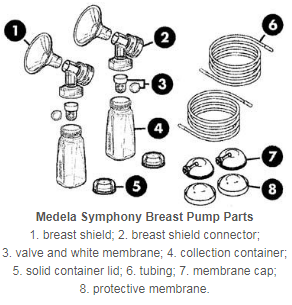Breastmilk For Your Hospitalized Infant
Breastfeeding Resources
Mothers who need to express milk for several weeks or months will need to use a hospital grade electric breast pump.
When to Use the Pump
Start pumping as soon as possible. You should pump every 2 to 3 hours around the clock to build and maintain your milk supply. You should be pumping a minimum of 8 times every 24 hours. After the second week, if you have a well-established milk supply, it is okay to sleep 5 to 6 hours at night without pumping. How long you pump is different from mother to mother. A good rule is to pump for at least 15 to 20 minutes. Stress and and being over tired can affect your milk supply, so try to rest as often as possible.
Electric breast pumps are available for you to use while your child is at Nationwide Children’s. Some insurance companies will pay for you to rent a hospital-grade breast pump if you have a prescription. For more information, or for help renting a breast pump, please contact the Lactation Team.
Pumping with an Electric Breast Pump

Before using the electric pump, gather the things you need. Your baby’s nurse or a Lactation Team member will help you with this and teach you how to use the equipment.
-
Wash your hands very well with soap and warm water for 15 seconds.
-
Place the breast shield over the breast, centered over the nipple.
-
Pump both of your breasts at the same time for at least 15 to 20 minutes.
-
Pumping should not hurt. If you have any pain while pumping, be sure to tell a Lactation Team member.
Storing Breastmilk
-
After you have finished pumping, pour the milk into sterile containers that the nurse gives you.
-
Label the milk container with the barcoding labels that the nurse gave you. Please write the date and time of the milk collection. Also, write any medicines or herbs you have taken in the past 2 hours on the label.
-
Store your breast milk based on your baby’s feeding plan. Expressed milk can be kept in the refrigerator for up to 48 hours. It can be frozen in a refrigerator freezer for up to 3 months and in a deep freezer for up to one year.
-
Pack the milk with freezer packs in a cooler when you bring it to the hospital.
-
When you visit your baby at the hospital, give your breast milk to a staff member to store in the freezer or refrigerator.
Equipment Care
Clean equipment is is very important when giving your baby a safe supply of your milk!
| Washing Pump Parts at the Hospital | Washing Pump Parts at Home |
|---|---|
| 1. Wash your hands with warm, soapy water. | 1. Wash your hands with warm, soapy water. |
| 2. Separate the pump parts and collection bottles that have come in contact with your milk and need to be cleaned | 2. Separate the pump parts and collection bottles that have come in contact with your milk and need to be cleaned. |
| 3. Wash your pump parts and collection bottles with dish soap and sterile water in a hospital basin that the nurse gives you. Do not use the antibacterial soap in the dispenser at the sink. Do not wash the tubing. | 3. Wash your pump parts and collection bottles with dish soap and hot water. Do not wash the tubing. |
| 4. Rinse your pump parts and collection bottles with sterile water and dry them with clean paper towels. | 4. Rinse your pump parts and collection bottles with hot water and dry them with a clean towel. |
| 5. Let the pump parts and collection bottles air-dry completely before putting them back together. | 5. Let the pump parts and collection bottles air-dry completely before putting them back together. |
| 6. Sterilize the parts and collection bottles once every 24 hours. Do this by boiling them in water for 15 minutes or running them through a dishwasher using the hot water cycle. If you do not have a dishwasher or cannot do the boiling water method, the Medela Quick Clean™ Micro-Steam bag is acceptable. | 6. Sterilize the pump parts and collection bottles once every 24 hours. Do this by boiling them in water for 15 minutes or by running them through a dishwasher using the hot water cycle. If you do not have a dishwasher or cannot do the boiling water method, the Medela Quick Clean™ Micro-Steam bag is acceptable. |



